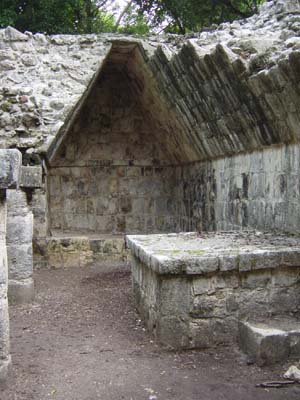
If you are fortunate to arrive early at Chichén Itzá, you may get to see the site through a veil of moisture, and not the humidity you will encounter later in the day! Here’s a building across the plaza from the largest pyramid. You can’t climb into this structure, so from this vantage point is your best chance of seeing the top. Think of what the barren plaza was like back when the site was occupied and you could walk between those columns in the shade.

Chichén Itzá has many ball courts, researchers say, but in the area open to tourists we found only two. Most people visit only one, and it’s spectacular—the largest known in Mesoamerica! We duck-walked through a low doorway into this roofless sweatbath adjacent to that second ball court (which is unexcavated). Players and perhaps others visited this structure for purification rituals associated with ball court activities.
The Maya, in choosing stone as their construction material, were faced by a big engineering problem: how to encompass larger spaces safely. Their solution was this pointy interior space, the corbeled arch, in which each stone extended a bit further toward the interior than the one below it. I’m sure squads of stoneworkers were continuously busy maintaining these buildings. Over time, due to limitations in raw material and labor availability, Maya laborers used less mortar in construction, although this is not evident in this moment, frozen in time. Look again, smell the herbs scenting the steam?